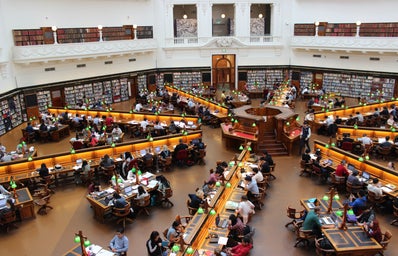This month, the Raymond H. Fogler library has added a new resource for University of Maine students to utilize in their academic research (or outfit inspiration…).
As of Nov. 3, UMaine students have full access to The Vogue Archive; a complete collection of every Vogue issue from Dec 17, 1892 (the first printing) to the latest edition.
Every single cover, page, fold-out and advertisement from the past 123 years is included in the form of high-resolution, digital color pages. The Archive gives users the opportunity to browse, or conduct a basic or advanced search. The advanced search option provides the ability to search specific companies, brands, photographers and persons pictured. (So yes, you can totally do a search for Calvin Klein underwear advertisements. You’re welcome.)
So, how did Fogler just become the fashion capital of Orono? Because librarians are super helpful. Duh.
Jen Bonnet, Fogler’s Social Sciences and Humanities Librarian, regularly assists students in their research. Recently, she met with undergraduate thesis writer Annette Ambrose, who was working on her Art History capstone.
“I had planned to study the intersection of art, specifically fashion photography, and advertising,” said Ambrose. “My lifelong interest in fashion and magazines was fulfilled when I was able to use Vogue for an academic paper!”
Bonnet suggested that Ambrose use the Vogue Archive as a resource.
“It was clear from her thesis topic—centered on fashion photography—that the Vogue Archive would be an invaluable resource for her work,” said Bonnet.
After Ambrose and Bonnet’ s meeting, Fogler initiated a trial to determine how useful the Vogue Archive could be for UMaine students. The trial proved what most fashion-savvy readers already know; Vogue is more than just an interesting read while you’re waiting for your highlights to process at the salon—it’s a valuable resource.
“I am very excited to use Vogue in this manner,” said Ambrose. “I feel like people have a tendency to look down on magazines and see them as frivolous, but the varied usefulness of this archive is proving that false!”
Ambrose was able to not only use Vogue as a resource, but to incorporate it into her research. After discovering that the topic of fashion photography and advertising is quite broad, Ambrose adjusted her thesis to focus on the work of Irving Penn—a photographer known for his work with Vogue.
“Rather than limiting my use of Vogue, this new focus has actually increased it, as Irving Penn did so much work for Vogue,” said Ambrose.
According to Bonnet, the trial was a success. A Communications and Journalism professor used Vogue as a resource for his book project. Students gathered primary documents for a journalism history course assignment. English students used articles as supplements for a class discussion.
“It was clear that this resource would have wide-ranging interest and research potential for students and faculty across campus,” said Bonnet.
As a result, Fogler’s Collections Services Coordinator worked with a vendor called ProQuest to purchase access to the archive.
Bonnet noted that the archive’s benefits exceed serving as a resource for Communication and Art History students. “The archive has great research potential for students working on topics in history, popular culture, women’s and gender studies, photography, marketing and fashion.”
Full access to the archive is available on and off campus through the Fogler Library website.
“We are delighted to work with students and encourage them to be in touch with us,” added Bonnet. “We can help brainstorm directions for class projects, potential sources to use in assignments, and how to use library resources to support their work.”
Need research help? Contact the Fogler librarians. Who knows? It might turn into something more than help with your paper.

